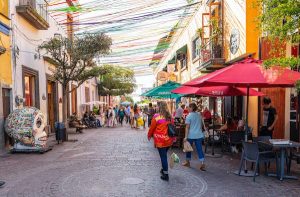
Cuban cuisine has come a long way in the last decade. Until the late 2000s, shortages were a way of life, and the nation’s default snack was a sandwich stuffed with tinned ham and rubbery cheese (the real Cuban sandwich is an invention of Cuban Americans in the US).
Reforms in the early 2010s widened the goalposts for private entrepreneurs, and innovative restaurants quickly began to proliferate. Today, with professionally minded chefs sharpening their creative knives, the country – despite the recent blip caused by the COVID-19 pandemic – is rediscovering its culinary roots.
Here are some of the best Cuban dishes and where you can taste them.
Ready to start planning? Sign up for our weekly newsletter and get 20% off your next guidebook.
Chow down on ropa vieja, Cuba’s national dish
Cuba’s national dish – slow-cooked shredded beef in a tomato sauce – was hard to procure during the Special Period, the era of economic austerity that lasted from the early 1990s until the late 2000s. Problems with the food supply meant private restaurants were prohibited from serving beef – killing a cow or illegally selling its meat could mean jail time. Fortunately, restrictions were relaxed in the 2010s and ropa vieja has subsequently leaped back into vogue.
The dish, whose name translates as “old clothes,” has Spanish roots. It’s said to have originated with Spain’s Sephardic Jewish community about 500 years ago, minus the tomatoes which weren’t common in Europe until the 18th century. Traditionally the meat was slow-cooked the night before the sabbath (when cooking was forbidden) to lend it an intense but nuanced flavor.
Spanish versions of the dish usually contain chickpeas, while the Cuban rendition combines shredded steak (flank, brisket or skirt) with peppers and onions in a rich tomato sauce. It might look like old clothes, but it certainly doesn’t taste like them! The recipe probably arrived in Cuba from the Canary Islands, along with many of the country’s early European colonizers, and first established itself in Havana.
Where to try it: Today, any Cuban restaurant worth its salt will serve ropa vieja, and the meal is often held up as a litmus test of a place’s general food quality. El Rum Rum de la Habana in Old Havana does a superb version.
 Sweet and comforting picadillo a la Habanera is one of Cuba’s most satisfying stews © Magrig / Getty Images
Sweet and comforting picadillo a la Habanera is one of Cuba’s most satisfying stews © Magrig / Getty Images
Pig out on picadillo a la Habanera
A close cousin of ropa vieja, picadillo de la Habanera is a spicy melange of ground beef, olives and raisins slow-stewed until it achieves a deep, satisfying and subtly sweet flavor. Herbs and spices, including cumin, oregano and garlic, are also thrown into the mix.
The dish was originally considered a meal of the poor, and mincemeat or hash was used to hide cheaper, less desirable cuts of meat. These days, picadillo has a distinctly richer reputation. The olives testify to Spanish roots while the sides – tostones (pan-fried plantain), rice, beans and root vegetables – reflect more Caribbean influences.
Where to try it: For the best picadillo in Havana, proceed to Callejón del Chorro, a narrow cul-de-sac near Havana’s cathedral. Tucked away at the end of the street is Doña Eutimia, a private restaurant that excels in traditional Cuban cuisine cooked in a no-nonsense, unfancy way. Frankly, you could plump for any of the restaurant’s myriad dishes, but their picadillo is the best of the best.
Slurp down some ajiaco
You can’t get more Cuban than an ajiaco, a broth-like stew with antecedents in the pre-Columbian era. Fernando Ortiz, the famous Cuban anthropologist, once likened the country’s culture to an ajiaco, a combination of heritage from Africa, Spain, France, China and the indigenous Taínos.
The stew contains a potpourri of various meats, vegetables, fruits, corn and flavorings. The Taíno people used to make it in large clay cauldrons using gamey meats (the resident jutía or tree rat was popular), root vegetables such as yucca and squash, and the sweet aji peppers from which the dish gets its name. Hot peppers are little used in Cuba, whose residents don’t have much taste for strong spices. The Spanish introduced new meats such as beef and pork, although ajiaco’s proteins were pared down during the lean years of the 1990s and 2000s.
Where to try it: It is still mostly considered a rustic “soup” made up of scraps and leftovers, but it’s creeping into fashion in places like Ajiaco Café, an eco-restaurant in the Havana suburb of Cojímar.
 You can’t visit Viñales without indulging in some
You can’t visit Viñales without indulging in some
Devour some roasted cochinillo asado
Spit-roasted suckling pig comes a close second to ropa vieja as Cuba’s national dish and is a popular communal meal at Christmas and New Year. It’s most authentic when cooked alfresco in the countryside over an open charcoal fire pit. The roasting process can take up to seven hours and is extremely labor intensive.
The bucolic region in and around the tobacco-growing town of Viñales in Pinar del Río province is the spiritual home of cochinillo asado. In the last decade or so, a plethora of rustic eco-farms has sprung up presenting the feast in an idyllic rural setting. Finca Agroecológica El Paraíso is a leading light.
The roast pork usually comes with a smorgasbord of typical Cuban trimmings, including moros y cristianos (rice and beans cooked and seasoned in the same pot), plantains prepared in a variety of ways and vegetables.
Where to try it: At El Paraíso, almost everything is grown and made on site. Other restaurants where you’re likely to get good renderings of roast pork are Balcón del Valle just outside Viñales, and Casa Mía Paladar in Havana’s Vedado neighborhood, which offers cerdo (pork) done Pinar del Río style.
Pig out on pescado con lechita
When it comes to food, Baracoa in Cuba’s far eastern corner inhabits a separate universe from the rest of the country. Geographic isolation and a wet, fickle climate have ensured different crops prosper here: coconuts and cocoa grow abundantly, and a tiny freshwater fish called teti thrives in the local rivers. All of this bounty (and more) finds its way onto the local dinner plates.
Arguably the most delicious Baracoan specialty is a coconut sauce called lechita commonly served over fish. Lechita is made using coconut milk, tomatoes, and garlic and adorns most of the local river- and seafood, including swordfish, prawns or the teti drawn from the nearby Toa River between July and December during a waning moon.
Where to try it: Legendary in Baracoa is the private restaurant La Colonial, which has been knocking out the local favorites doused in lechita for more than 20 years.
 Jump in a car and head to Baracoa to sample its unique dishes such as cucurucho and pescado con lechita © lisegagne / Getty Images
Jump in a car and head to Baracoa to sample its unique dishes such as cucurucho and pescado con lechita © lisegagne / Getty Images
Cram down cucurucho, a special Cuban pudding
Cucurucho is a unique Cuban dessert found only in and around the city of Baracoa in the eastern province of Guantánamo. It is made from sweet local ingredients that include coconut, guava, pineapple, almonds and honey – no two recipes are exactly alike. Heated and cooked in a pan to make a sticky paste, the concoction is subsequently cooled and wrapped in a cone-shaped palm frond.
Where to try it: Local people sell it roadside on the steep, winding Farola (lighthouse road), the only decent road connection between Baracoa and the outside world.
Try pollo asado “El Aljibe”, a fave of diplomats
Naranja agria (bitter orange) is a key but subtle ingredient in many Cuban dishes, but its distinctive flavor dominates the menu at one particular restaurant in Havana’s diplomatic quarter.
First opened in 1993, El Aljibe is a direct descendent of a rustic farm restaurant called Rancho Luna, founded by two brothers, Pepe and Sergio García, in 1946. Rancho Luna was located in the town of Guanajay, 50km (31 miles) west of Havana, and built a formidable reputation on the power of one dish, pollo a lo tinguaro, or barbecued chicken glazed in a “secret” bitter orange sauce.
The restaurant prospered in the 1950s, but it was nationalized and forced to close after the revolution. Thirty years later, the brothers decided to relaunch the place as a state-run enterprise called El Aljibe in Havana’s Miramar district.
Where to try it: To recreate the rustic idyll, El Aljibe is housed beneath an open-sided thatched canopy where the vast majority of its clientele revel in ordering the erstwhile barbecued chicken (renamed pollo asado “El Aljibe” after the restaurant) served with ample all-you-can-eat sides of rice, beans, tostones and salad. Combining large portions with sharp service, it’s arguably the best state-run restaurant in Cuba.
Live it large with some freshly-caught langosta
On the largest island in the Caribbean, it’s not uncommon to find abundant and succulent seafood. Langosta (lobster) has long been an affordable option for tourists paying in convertible currency, and in recent years, it has become permissible for private restaurants to sell it. Portions of the rich crustacean are large, and the flavoring is simple yet subtle. It’s served in the shell with little more than butter and some light seasoning.
Where to try it: Many open-sided beach restaurants, called ranchones, in resort zones, serve fresh lobster. Named after a beloved Canadian tourist, Lenny’s Lobster Shack abutting Playa Prohibida in Cayo Coco is famed for its lobster, prawns and fish medley. Varadero 60 in the eponymous resort town offers lobster as a surf-and-turf option with steak.
Make a beeline for a mojito at Bodeguita del Medio
In the holy trinity of Cuban cocktails, the mojito is easily the most popular. Almost every Cuban bartender worth their salt knows how to mix a passable mojito by blending white rum (preferably Havana Club), sugar, lime juice, soda, and hierba buena (a citrusy type of Cuban mint).
Where to try it: Unsurprisingly, there are numerous places that serve fabulous (and strong) mojitos. Havana’s Bodeguita del Medio claims to be the cradle of the drink with its fame linked to the one-time patronage of American writer and international barfly, Ernest Hemingway. The bar/restaurant has become a franchise in recent years with establishments opening in other Cuban towns including Varadero and Santa Clara, as well as numerous branches abroad. However, many of Cuba’s best mixologists have migrated to the private sphere. If Hemingway were alive today he’d probably just as likely procure his mojitos in neo-bohemian joints such as El del Frente.
Cool off with a frozen daiquiri
Invented in El Floridita, a grandiose bar on the cusp of Habana Vieja and Centro Habana, in the late 1910s, the frozen daiquiri (made with rum, lime, sugar, and crushed ice) was popularized by – guess who? – Ernest Hemingway in the 1940s. The American scribe knocked back copious double-shots in the confines of this atmospheric establishment where the current prices reflect its prime position on the list of the world’s greatest ‘Hemingway-once-got-smashed-in-here’ bars.
Where to try it: For budget drinkers, the cocktail is cheaper and, arguably, more refreshing just around the corner in the more beatnik El Dandy.
Vegetarians and vegans
In a country where rationing and food shortages are an ongoing reality, strict vegetarians and vegans will need patience and resolve. Vegetarianism doesn’t have deep roots in Cuba and choices outside Havana can be limited to omelets and scrambled eggs. The situation has improved a little in the last decade. Cooks in casas particulares (private homestays), who may already have had experience cooking meatless dishes for other travelers, are usually pretty good at accommodating vegetarians. The same goes for some of the more pioneering and creative private restaurants, many of which have started to develop menus with meat-free sections.
Havana and Viñales (which has a strong local farming culture) have recently sprouted some decent specialized vegetarian restaurants. Expect more to follow. The completely meat-free Camino al Sol in Havana’s Vedado district cooks up interesting quiches, soups, and risottos and crafts its own house-made pasta. La Berenjena in Viñales plies smoothies, vegetable lasagna, wraps, soups, and a few meat dishes for incurable carnivores. El Romero in the small eco-village of Las Terrazas uses solar power and homegrown herbs and vegetables to fabricate veggie cremas (soups), pies, rice concoctions, tempuras, and crepes.
Food worth trying
Guarapo A sweet cane juice popular in agropecuarios (food markets) and sometimes served roadside in parts of rural Cuba. It’s made by passing raw sugar cane through a pressing machine to extract its juice and then mixing it with lime and ice. Many Cubans swear by it as an aphrodisiac.
Mamey A large fruit with a hard shell and sweetish red flesh similar in consistency to an avocado. Rarely eaten raw, it’s usually served in batidos (milkshakes) or used to flavor ice cream.
Timba A simple but classic Cuban dessert consisting of a slice of yellow cheese served with a wedge of guava paste.
A year in food
In a country with an emerging food culture, Cuba doesn’t have many notable food festivals although some traditional annual shindigs (New Year’s Day, July 26th) involve plenty of eating and drinking. Some fruits in Cuba are seasonal; others are available year-round.
June-August
Mangos ripen between June and August and are exquisite at these times. It’s almost worth planning a trip around them.
August-December
Giant avocados are at their best between August and December



